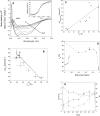Thermodynamics of unfolding of an integral membrane protein in mixed micelles
- PMID: 16600971
- PMCID: PMC2242483
- DOI: 10.1110/ps.052031306
Thermodynamics of unfolding of an integral membrane protein in mixed micelles
Abstract
Quantitative studies of membrane protein folding and unfolding can be difficult because of difficulties with efficient refolding as well as a pronounced propensity to aggregate. However, mixed micelles, consisting of the anionic detergent sodium dodecyl sulfate and the nonionic detergent dodecyl maltoside facilitate reversible and quantitative unfolding and refolding. The 4-transmembrane helix protein DsbB from the inner membrane of Escherichia coli unfolds in mixed micelles according to a three-state mechanism involving an unfolding intermediate I. The temperature dependence of the kinetics of this reaction between 15 degrees and 45 degrees C supports that unfolding from I to the denatured state D is accompanied by a significant decrease in heat capacity. For water-soluble proteins, the heat capacity increases upon unfolding, and this is generally interpreted as the increased binding of water to the protein as it unfolds, exposing more surface area. The decrease in DsbB's heat capacity upon unfolding is confirmed by independent thermal scans. The decrease in heat capacity is not an artifact of the use of mixed micelles, since the water soluble protein S6 shows conventional heat-capacity changes in detergent. We speculate that it reflects the binding of SDS to parts of DsbB that are solvent-exposed in the native DM-bound state. This implies that the periplasmic loops of DsbB are relatively unstructured. This anomalous thermodynamic behavior has not been observed for beta-barrel membrane proteins, probably because they do not bind SDS so extensively. Thus the thermodynamic behavior of membrane proteins appears to be intimately connected to their detergent-binding properties.
Figures



Similar articles
-
Folding of DsbB in mixed micelles: a kinetic analysis of the stability of a bacterial membrane protein.J Mol Biol. 2003 Jul 18;330(4):641-9. doi: 10.1016/s0022-2836(03)00624-7. J Mol Biol. 2003. PMID: 12850136
-
Protein unfolding in detergents: effect of micelle structure, ionic strength, pH, and temperature.Biophys J. 2002 Oct;83(4):2219-30. doi: 10.1016/S0006-3495(02)73982-9. Biophys J. 2002. PMID: 12324439 Free PMC article.
-
Using micellar mole fractions to assess membrane protein stability in mixed micelles.Biochim Biophys Acta. 2005 Oct 1;1716(1):59-68. doi: 10.1016/j.bbamem.2005.08.006. Biochim Biophys Acta. 2005. PMID: 16168383
-
An unfolding story of helical transmembrane proteins.Biochemistry. 2006 Dec 12;45(49):14559-66. doi: 10.1021/bi0620454. Biochemistry. 2006. PMID: 17144649 Free PMC article. Review.
-
How do surfactants unfold and refold proteins?Adv Colloid Interface Sci. 2022 Oct;308:102754. doi: 10.1016/j.cis.2022.102754. Epub 2022 Aug 16. Adv Colloid Interface Sci. 2022. PMID: 36027673 Review.
Cited by
-
Dark nanodiscs for evaluating membrane protein thermostability by differential scanning fluorimetry.Biophys J. 2024 Jan 2;123(1):68-79. doi: 10.1016/j.bpj.2023.11.019. Epub 2023 Nov 20. Biophys J. 2024. PMID: 37978799 Free PMC article.
-
Malleability of the folding mechanism of the outer membrane protein PagP: parallel pathways and the effect of membrane elasticity.J Mol Biol. 2012 Feb 24;416(3):453-64. doi: 10.1016/j.jmb.2011.12.039. Epub 2012 Jan 8. J Mol Biol. 2012. PMID: 22245579 Free PMC article.
-
Unfolding of beta-sheet proteins in SDS.Biophys J. 2007 May 15;92(10):3674-85. doi: 10.1529/biophysj.106.101238. Epub 2007 Mar 9. Biophys J. 2007. PMID: 17351005 Free PMC article.
-
Accessibility of Cations to the Selectivity Filter of KcsA in the Inactivated State: An Equilibrium Binding Study.Int J Mol Sci. 2019 Feb 5;20(3):689. doi: 10.3390/ijms20030689. Int J Mol Sci. 2019. PMID: 30764559 Free PMC article.
-
Structure formation during translocon-unassisted co-translational membrane protein folding.Sci Rep. 2017 Aug 14;7(1):8021. doi: 10.1038/s41598-017-08522-9. Sci Rep. 2017. PMID: 28808343 Free PMC article.
References
-
- Aniansson E.G. and Wall S.N. 1974. On the kinetics of stepwise micelle association J. Phys. Chem. 78: 1024–1030.
-
- Brouillette C.G., Muccio D.D., Finney T.K. 1987. pH dependence of bacteriorhodopsin thermal unfolding Biochemistry 26: 7431–7438. - PubMed
-
- Creighton T.E. In Proteins. Structures and molecular properties . 1993. 2d ed. W.H. Freeman & Co, New York.
-
- Faham S., Yang D., Bare E., Yohannan S., Whitelegge J.P., Bowie J.U. 2004. Side-chain contributions to membrane protein structure and stability J. Mol. Biol. 335: 297–305. - PubMed
Publication types
MeSH terms
Substances
LinkOut - more resources
Full Text Sources

